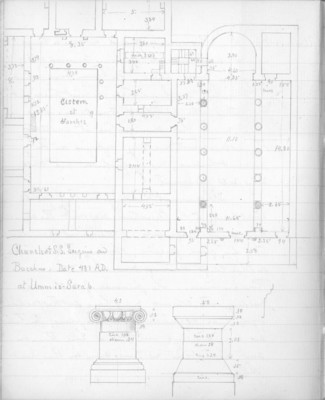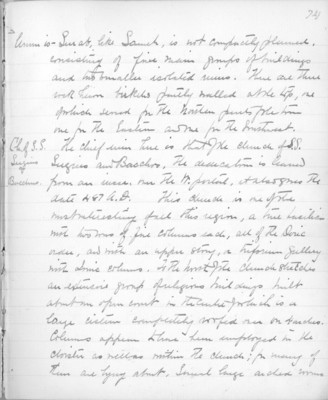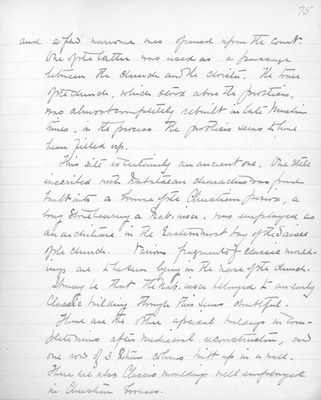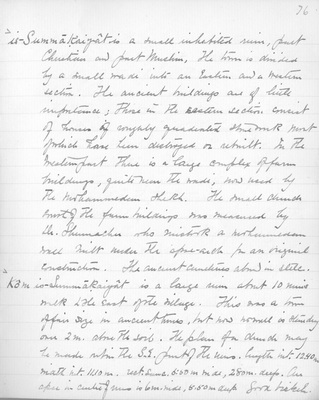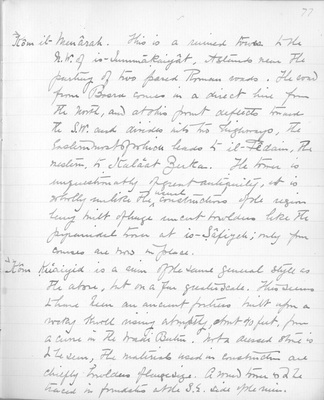Pages
BSY_FB_29-74-a
BSY_FB_29-74-b
74
V Umm is-Surab, like Sameh, is not completely planned, consisting of five main groups of buildings and two smaller isolated ruins. There are three rock [hewn] birkehs partly walled at the top, one of which served for the northern parts of the town one for the eastern and one for the Southwest.
Ch.of S.S. Sergius & Bacchus. The chief ruin here is that of the church of S.S. Sergius and Bacchus, the dedication is learned from an inscr. near the N. portal, it also shows the date 487 A.D. This church is one of the most interesting of all this region, a true basilican with two [rooms] of fine columns each, all of the Doric order, and with an upper story, or triforium gallery with Ionic columns. To the north of the church stretches an extensive group of religious buildings built about an open court in the centre of which is a large cistern completely roofed over on 4 arches. Columns appear to have been employed in the cloister as well as within the church; for many of them are lying about, several large arched rooms
BSY_FB_29-75
75
and a few narrower ones opened upon the court. One of the latter was used as a passage between the church and the cloister. The tower of the church, which stood above the peristasis was almost completely rebuilt in the late Muslim times, in the process the peristasis seems to have been filled up.
This site is certainly an ancient one. One stele inscribed with Nabataean characters was found built into a house of the christian period, a long stone bearing a Nab. inscr. was employed as an architrave in the Eastern most bay of the S. aisle of the church. Ruinious fragments of classic mouldings are to be seen lying in the nave of the church.
It may be that the Nab. inscr. belonged to an early classic building though this seems doubtful.
There are two other apse and buildings in complete ruins after medieval reconstruction, and one now of 3 Xtian columns built up in a wall.
There are also classic mouldings well employed in christian houses.
BSY_FB_29-76
76
V is-SummāḲaiyât is a small inhabited ruins, part Christian and part Muslim. The town is divided by a small wadi into an Eastern and a Western section. The ancient buildings are of little importance; those in the Eastern section consist of houses of roughly quadrated stone work most of which have been destroyed or rebuilt. In the Western part there is a large complex of farm buildings, quite near the wadi; now used by the Mohammedan sheikh. The small church south of the farm buildings was measured by Dr. Shumacher who mistook a Mohammedan well built under the apse-arch for an original construction. The ancient cemeteries abound in stele.
V K3m is-SummāḲaiyât is a large ruin about 10 minute walk to the East of the village. This was a town of fair size in ancient times, but now no wall is standing over 2 m. above the soil. The plan of a church may be made within the S.E. part of the ruins. Length int. 12.40m width int. 11.10m. rect. Sunc 6:60m wide, 280m. deep. An apse in centre of ruins is 6m. wide, 5.50m deep. Good birkeh.
BSY_FB_29-77
77
V Kôm il-Menârah. This is a ruined tower to the N.W. of is-SummāḲaiyât, it starts near the parting of two paired Roman roads. The road from Bosra comes in a direct line from the North, and at this point deflects towards the S.W. and divides into two highways, the Eastern most of which leads to il-Fêdain, the Western to Kala'at Zirka. The tower is unquestionably of great antiquity, it is wholly unlike the ^ usual ^ constructions of the region being built of huge uncut boulders like the pyramidal tower at is-Sâfiyeh; only form courses are now in place.
V Kôm Ku'aiyid is a ruin of the same general style as the above, but on a greater scale. This seems to have been an ancient fortress built upon a rocky knoll rising abruptly, about 40 feet, from a curve in the Wadi Butin. Not a dressed stone is to be seen, the materials used in construction are chiefly boulders of large size. A wood tower is the traced in foundations at the S.E. side of the ruins.
